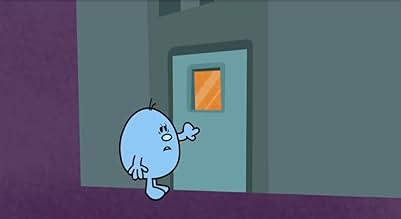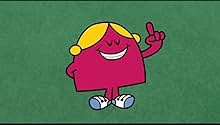Sfoglia gli episodi
Trama
Lo sapevi?
- QuizThe Barbapapas are creatures that can change their form, and those are the adventures is this unusual family.
- ConnessioniFollows Barbapapa (1973)
Recensione in evidenza
Barbapapa and his colorful family returned to television 25 years after the original series and at first glance, nothing seems to have changed. The animation style is still the same. It's quite a relief to see they did not digitize Barbapapa and turn him into a computer generated blob (pitty the tots growing up with the new cgi Micky Mouse Club). However, there are some difference. The Dutch version now has different people doing the voices instead of just one narrator (even though the Barbapapa's hardly ever move their mouths). The characters never use their old catchphrase before transforming anymore ('Clickety Click Barba Trick' in English, 'Huub Huub Barbatruuk' in Dutch) and the episodes feature no new songs. There are new opening and ending themes, which apparently were very difficult to translate from the original French, for most of the Dutch lyrics are totally incomprehensible to me. Perhaps this is why it took 7 years for this new series to arrive in Holland, a time in which the old Seventies series was almost continuously being repeated.
One of the Barbakids, animal lover Barbidou (Barbazoo in English, Barbabee in Dutch) longs to film wild animals with his little camera. Since there are none to find around the Barbapapa's home (presumably in France), the entire family decides on the spot to make a trip around the world. And so they're off to capture rare and endangered species (on film that is). Of course, the Barbapapa's often used to be called some sort of animals themselves and must surely be the rarest and most unusual of all. They visit New Guea, Sumatra, Australia, The Himalays, Borneo, India, the Amazon, China, Scandinavia, North America, Africa, Madagascar, The Galapagos Islands, The North Pole and the Antartic and introduce young viewers to all sorts of rare mammals like flying frogs, slime fish, horn birds. However with each story lasting a mere 5 minutes, I wonder how much of this information has a lasting impression.
The family themselves is portrayed as tourists. The aforementioned Barbidou carries a video camera, his vain sister Barbabelle takes photographs, the musical Barbalala has a waterproof microphones to record Wale songs and Barbamama occasionally wears a big floppy sun hat. During all these travels, the family never meets any humans (although one time they mistook a drowning nose-ape for a man). What a wonderful world. Occasionally the bunch of colorful blobs is seen steering a (hired?) boat or even driving a train, but there are no destructive homo sapien in sight. They usually and end up losing or discarding any mode of transport in favor of transforming themselves into a Barbavehicle before the 5 minute episode is over anyway. The family celebrates Halloween in Scandinavia, where a hungry Wolverine steals their diner, and makes a Barba-Christmas tree amongst the upside down trees and death-heads monkeys of Madagascar. In the antarctic they build their own igloo to sleep in, but on the Galapoli Isles they prefer the safety of their own bodies after morphing into a combined Barbacastle.
Barbidur (Barbabravo in English, Barbaborre in Dutch), aka the red one, probably gets the most to do during the series and is the only character who has undergone a bit of a personality change. He's still the sporty one, but this time around he's always hungry (usually chomping down bags of popcorn) and is the least interested in traveling and learning about exotic animals (at one point describing a walrus as a giant sausage with tusks). He does love his dog Lolita, who is constantly at his side and likes to copy his movement. Usually it is one of these (if not both) who gets into trouble during each stand alone 5 minute episode. Poor Lolita especially never seems to get a break. She's attacked by polar bears, kidnapped by orangutans and hurts herself walking on dangerous reefs. Much less time is spend on Barbotine (Barbalib in English, Barbabientje in Dutch) who occasionally loses her glasses and Barbouille (Barbabeau in English, Barbabob in Dutch) who sometimes gets into trouble trying to paint a picture or sculpt a sculpture on the way. Funny how Barbabob has the same hobby and the same wild and shaggy hair as the late Bob Ross. Coincidence? Blue Barbidur (Barbabright in English, Barbabenno in Dutch), being the scientific one, hardly ever gets anything to do at all.
It becomes a little bit preachy at times, and exciting escapades including volcanic eruptions, American tornado's and avalanches only occasionally pop up. Usually the Barbapapa's are traveling along and mistake a giant turtle for a rock to sit on or a Maribu's beak for a banana (running gag). For the age group this is intended for however, it's a great, innocent little cartoon hearkening back to the mellow children's entertainment of thirty years ago and it's educational as well (one episode even refers to the mythological Jason and the Golden fleece). On a side note, Dutch broadcaster N.O.S. somehow managed to get the audio and visual tracks on several episodes mixed up on a couple of broadcasts, leading to a very trippy experience.
8 out of 10
One of the Barbakids, animal lover Barbidou (Barbazoo in English, Barbabee in Dutch) longs to film wild animals with his little camera. Since there are none to find around the Barbapapa's home (presumably in France), the entire family decides on the spot to make a trip around the world. And so they're off to capture rare and endangered species (on film that is). Of course, the Barbapapa's often used to be called some sort of animals themselves and must surely be the rarest and most unusual of all. They visit New Guea, Sumatra, Australia, The Himalays, Borneo, India, the Amazon, China, Scandinavia, North America, Africa, Madagascar, The Galapagos Islands, The North Pole and the Antartic and introduce young viewers to all sorts of rare mammals like flying frogs, slime fish, horn birds. However with each story lasting a mere 5 minutes, I wonder how much of this information has a lasting impression.
The family themselves is portrayed as tourists. The aforementioned Barbidou carries a video camera, his vain sister Barbabelle takes photographs, the musical Barbalala has a waterproof microphones to record Wale songs and Barbamama occasionally wears a big floppy sun hat. During all these travels, the family never meets any humans (although one time they mistook a drowning nose-ape for a man). What a wonderful world. Occasionally the bunch of colorful blobs is seen steering a (hired?) boat or even driving a train, but there are no destructive homo sapien in sight. They usually and end up losing or discarding any mode of transport in favor of transforming themselves into a Barbavehicle before the 5 minute episode is over anyway. The family celebrates Halloween in Scandinavia, where a hungry Wolverine steals their diner, and makes a Barba-Christmas tree amongst the upside down trees and death-heads monkeys of Madagascar. In the antarctic they build their own igloo to sleep in, but on the Galapoli Isles they prefer the safety of their own bodies after morphing into a combined Barbacastle.
Barbidur (Barbabravo in English, Barbaborre in Dutch), aka the red one, probably gets the most to do during the series and is the only character who has undergone a bit of a personality change. He's still the sporty one, but this time around he's always hungry (usually chomping down bags of popcorn) and is the least interested in traveling and learning about exotic animals (at one point describing a walrus as a giant sausage with tusks). He does love his dog Lolita, who is constantly at his side and likes to copy his movement. Usually it is one of these (if not both) who gets into trouble during each stand alone 5 minute episode. Poor Lolita especially never seems to get a break. She's attacked by polar bears, kidnapped by orangutans and hurts herself walking on dangerous reefs. Much less time is spend on Barbotine (Barbalib in English, Barbabientje in Dutch) who occasionally loses her glasses and Barbouille (Barbabeau in English, Barbabob in Dutch) who sometimes gets into trouble trying to paint a picture or sculpt a sculpture on the way. Funny how Barbabob has the same hobby and the same wild and shaggy hair as the late Bob Ross. Coincidence? Blue Barbidur (Barbabright in English, Barbabenno in Dutch), being the scientific one, hardly ever gets anything to do at all.
It becomes a little bit preachy at times, and exciting escapades including volcanic eruptions, American tornado's and avalanches only occasionally pop up. Usually the Barbapapa's are traveling along and mistake a giant turtle for a rock to sit on or a Maribu's beak for a banana (running gag). For the age group this is intended for however, it's a great, innocent little cartoon hearkening back to the mellow children's entertainment of thirty years ago and it's educational as well (one episode even refers to the mythological Jason and the Golden fleece). On a side note, Dutch broadcaster N.O.S. somehow managed to get the audio and visual tracks on several episodes mixed up on a couple of broadcasts, leading to a very trippy experience.
8 out of 10
- Chip_douglas
- 21 mag 2007
- Permalink
I più visti
Accedi per valutare e creare un elenco di titoli salvati per ottenere consigli personalizzati
Dettagli
- Data di uscita
- Paesi di origine
- Celebre anche come
- Barbapapa rond de wereld
- Aziende produttrici
- Vedi altri crediti dell’azienda su IMDbPro
- Tempo di esecuzione5 minuti
- Colore
Contribuisci a questa pagina
Suggerisci una modifica o aggiungi i contenuti mancanti

Divario superiore
What is the English language plot outline for Barbapapà in giro per il mondo (2001)?
Rispondi






